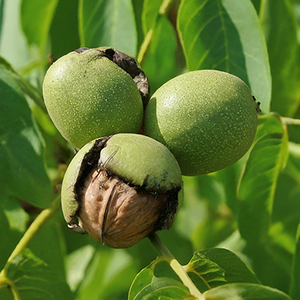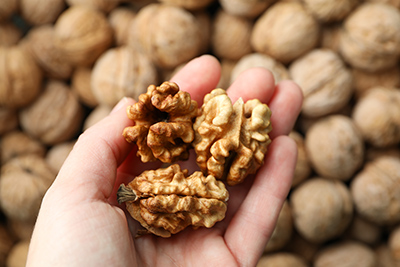Contents
Apart from the many walnut health benefits, it is believed that the walnut originated in Central Asia and has long adapted very well to the countries surrounding the Mediterranean. For millennia, walnuts have formed part of the Mediterranean diet, which is praised for its beneficial effects on health and the heart.
Walnuts have always been a part of the lives of Southern European peasants. One traditional meal among laborers in northern Spain, based on whole-grain bread and walnuts, has given them health and strength even during tough times.
In the sixteenth century, Spanish sailors brought walnuts to North America. They acclimated particularly well in California, one of the world’s largest producers of these nuts. California walnuts are large and attractive, although gourmets still prefer the flavor of the smaller and wrinkled nuts from the old Mediterranean trees.

Walnut Scientific Facts
- Scientific name: Juglans regia L.
- Other names: Persian walnut, heartnut.
- French: Noix.
- Spanish: Nuez.
- German: Walnuss.
- Description: The walnut is the seed of the fruit of the walnut tree, a tree of the botanical family Juglandaceae that grows to a height of 20 meters. The fruit is a drupe whose fleshy portion (pericarp and mesocarp) is greenish; the seed or endocarp is woody and hard, but it contains a very nutritious dicotyledonous seed: the walnut.
- Environment: Walnuts require a temperate, cool climate. They grow well in valleys and other places protected from freezing in winter. Today, their cultivation has extended throughout the world’s temperate regions, Europe, Asia, and North America.
Walnut Nutrients
The walnut is, together with other oil-bearing nuts, one of nature’s most concentrated food sources of nutrients. Together with the Brazil nut, it is the nut with the highest caloric content due to its high fat content. These are the characteristics of the walnut’s nutrients:

Fats – These makeup three-fifths of the weight of the nut, which is superior to almonds, hazelnuts, and peanuts. These facts are formed primarily of unsaturated fatty acids, with a preponderance of polyunsaturated and lecithin. Among the two fatty acids found in walnuts, these two stand out:
- Linoleic acid (32.8 percent), with eighteen carbon atoms and two double bonds. This is an essential fatty acid the body cannot be without, particularly during infancy. It lowers cholesterol levels and is involved in the formation of nerve tissue and the production of antibodies. With 13.8 grams per hundred, walnuts are the wealthiest linoleic acid food source, surpassed only by sunflower seeds (32.6 percent). Soy, almonds, and other nuts closely follow walnuts. Beef, for example, contains only 0.58 percent linoleic acid, fifty-four times less than walnuts.
- Linolenic acid (6.8 percent) has eighteen carbon atoms and three double bonds. It is an Omega-3 fatty acid, like those found in fish. It reduces cholesterol and triglyceride levels in the blood, prevents the formation of clots in the blood vessels, and decreases inflammatory processes.
Walnuts are one of the best vegetable sources of linolenic acid, along with wheat germ, primrose, and canola.
Carbohydrates—Walnuts are the lowest oil-bearing nut in this nutrient (13.5 percent). From a chemical viewpoint, these are oligosaccharides (dextrin) and a small number of sugars (saccharose and dextrose). Because of this, walnuts are well tolerated by people with diabetes.
Proteins—Walnuts contain up to 14.3 percent high–quality protein, more than peanuts and about the same as almonds. However, they are deficient in the essential amino acid methionine, which can be solved by combining them with whole grains (wheat, oats, rice, etc.), which are rich in methionine.
The mixture of nuts and grains is doubly beneficial because grains are deficient in lysine and threonine, two other essential amino acids that walnuts contain in abundance. Because of this, mixing walnuts and grains (bread, for example) provides complete proteins equal to or superior to meat.
Vitamins – Walnuts are a reliable source of vitamins B1, B2, B3, (niacin), and particularly B6. Vitamin B1 or thiamin is necessary for the heart’s function and the nervous system’s stability. They are poor in vitamins A and C. Walnuts are one of the richest sources of vitamin B6, also known as pyridoxine. Only wheat germ and certain fish, such as sardines or salmon, equal or surpass walnuts in vitamin B6. Meat and most fish contain half of a third as much as walnuts, and eggs and milk contain 10 to 20 times less. Vitamin B6 is involved in proper brain function and red blood cell production.
Minerals – Walnuts are rich in phosphorus and potassium while low in sodium, promoting cardiovascular health. They also comprise a substantial amount of iron, magnesium, and calcium, although almonds and hazelnuts are more prosperous in calcium.
Walnuts, along with other nuts, are one of the best sources of TRACE ELEMENTS. These minerals are found in minimal amounts in the body. They carry out numerous functions, some of which are still unknown. Walnuts are particularly rich in the following:
- Zinc: walnuts contain 2,730 ug (=2.73 mg) of zinc per 100 grams, an amount superior to all meats and fish except liver. Only brewer’s yeast, grains, and cheese surpass walnuts and peanuts in zinc content. Since most plant-based foods are poor in zinc, some investigators believe a vegetarian diet may be deficient in this vital trace element. Zinc deficiency leads to a weakening of the immune system and slow wound healing.
- Copper: Walnuts contain 1390 ug (=1.39 mg) of copper per 100 grams, more significant than most plant-based and animal-based foods. Only liver and oysters, products whose regular consumption is not recommended, surpass walnuts and other nuts in copper. This trace element facilitates iron absorption in the intestine and helps prevent anemia.
- Manganese: Walnuts contain 2900 ug (=2.9 mg) of this trace element per 100 grams, surpassed only by hazelnuts, soy, beans, and whole grains. Meat, fish, eggs, and milk are poor in manganese, which is necessary for reproductive functions. Manganese deficiency produces sterility in both sexes.
Walnut Health Benefits
With this rich and varied nutritional composition, walnuts have the following therapeutic applications:
Coronary disease – Walnuts are an excellent food for those suffering from coronary disease for three reasons:
- Thanks to their richness in fatty acids, walnuts are the primary energy source for the heart’s cells, unlike other cells, including neurons, which use glucose as their primary fuel. The heart is said to operate on fatty acids, and because of this, walnuts deliver ample energy for heart function.
- Because of its vitamin B1 content, which, despite being moderate, contributes sufficiently to adequate muscle function, including the heart, the lack of vitamin B1 produces cardiac failure and deterioration of the nervous system, which in advanced stages constitutes the disease of beriberi.
- They inhibit the obstructive buildup of cholesterol on artery walls by reducing blood cholesterol levels. The less cholesterol in the blood, the lower the risk of arteriosclerosis (obstruction of the arteries), and blood circulation is improved.
For these three reasons, walnuts are heart-friendly and should be included regularly in the diets of those suffering from heart failure for any reason, angina, or heart attack risk. Their consumption is recommended for those who have suffered a myocardial infarction and are in rehabilitation.

Elevated cholesterol—Until not long ago, the consumption of oil-bearing nuts, particularly walnuts, was discouraged for those with high cholesterol levels. However, investigations by Dr. Joan Sabaté at Loma Lind University (California) demonstrate that daily consumption of eighty grams of walnuts for two months reduces LDL (harmful) by sixteen percent.
Despite being extraordinarily rich in fats, walnuts reduce fat levels in the blood (the LDL lipoproteins that transport cholesterol). This arresting effect, paradoxical and unexpected by many, is due to the extraordinary composition of the fats in walnuts: seven times more unsaturated than saturated. These unsaturated fatty acids, including linoleic acid, stop the production of cholesterol in the liver.
With its positive effect on arteriosclerosis, this blood cholesterol-lowering action results when walnuts replace other foods such as margarine, butter, or sausage. This helps avoid the fattening mistakenly attributed to nuts.
Disorders of the nervous system – Walnuts are highly recommended for neurological disorders because of their abundance of essential fatty acids directly engaged in the neurons’ metabolism, lecithin, phosphorus, and vitamin B6. Because they enhance mental performance and re-establish tone and balance in the nervous system, they should be a vital part of the diets of knowledge workers and students. People suffering from depression, irritability, nervous exhaustion, or stress should eat at least a good handful of walnuts daily, preferably at breakfast.
Sexual disorders and sterility – one of the many roles of linolenic and linoleic acids, which are so plentiful in walnuts, is to serve as the base for synthesizing PROSTAGLANDINS. These substances carry out several functions, such as facilitating inflammatory reactions. It is also believed that they are involved in the physiological phenomenon associated with the sexual response; semen is rich in prostaglandins.

Because of this, walnuts’ vitamin B1 and B6 content, or their richness in trace elements, which facilitate many chemical reactions within cells, walnut consumption positively affects sexual performance: it increases a man’s potency and improves a woman’s sexual response.
It cannot be said that walnuts are an aphrodisiac in the strict sense of the word since walnuts do not increase sexual desire. Still, they facilitate the complex physiological reactions produced during sexual activity in both men and women.
Additionally, walnuts contain significant amounts of manganese, which increases sperm production and improves reproductive function. Regular walnut consumption can contribute to resolving cases of sterility and enhance a couple’s fertility, which is threatened by chemical contaminants in developed countries.
Diabetes – Because of their low carbohydrate content and high nutritional value, walnuts are one of the foods best tolerated by people with diabetes.
Increased nutritional needs—Because of their high caloric and nutritive value, walnuts are highly recommended for situations in which the body is involved in extraordinary effort, such as athletes, students preparing for examinations, pregnant or nursing women recovering from a debilitating disease, and physical stress in general.

The Walnut and the Brain
The relationship between walnuts and the human brain caused the ancients to believe that eating them would stimulate the function of this vital organ. According to the theory of signs, the Creator left specific signals in plants, so humans should discover their properties and relieve their suffering. This seems to be the case with walnuts.
Until the beginning of the twentieth century, humanity could not analyze the composition and properties of foods and plants. Indeed, intuition, applied to the theory of signs throughout history, provided positive results with walnuts and many other cases.
Walnuts Against Heart Attack
A study conducted in California, known as the Adventist Health Study, analyzed the dietary habits of more than 25,000 Seventh-Day Adventists, Christians universally recognized for their healthy lifestyle. The results showed that heart attack risk among Adventists is lower than that of the general population.
Additionally, those who ate walnuts five or more times a week had an even lower risk of heart attack: half of the Adventists in the study ate walnuts at least once a week.
Preparing Walnuts

1. Shelling
2. Sifting
3. Storage – Walnuts must be stored in well-closed containers and, if possible, in a vacuum. Because of their great richness in unsaturated fatty acids, they become rancid more rapidly than other oil-bearing nuts. This is due to the oxidation of fatty acids in contact with the air.
4. Eating walnuts – Walnuts must be chewed very slowly to aid digestion. For the elderly, children, and people with dental problems, walnuts can be ground until they form a paste.
5. Removal of the walnut’s skin – The skin or cuticle covering the walnut is extraordinarily rich in tannins and may be indigestible for those with stomach trouble. To do this:
- Scald the shelled nuts in hot water.
- Let them soak for several hours.
- The yellow skin can now be easily removed.
However, recent investigations have found that this skin covering the edible portion of the nut contains a substantial amount (4 percent) of ellagic acid, a phenolic compound like tannin, which may reduce cancer risk. Because of this, it is best to eat walnuts with the skin if it can be tolerated.
How to use Walnuts
- Raw and whole—Raw walnuts must be chewed very well. If they are indigestible, removing the thin yellow skin may help.
- Ground – Those quickly assimilate ground walnuts with chewing difficulty.
- Cooked—Walnuts can be used to make various delicious vegetarian dishes, including meat analogues and “meat” balls.
- Walnut oil is very flavorful and nutritious but is seldom available commercially because it quickly becomes rancid.
DISCLAIMER: All content on this website is presented solely for educational and informational objectives. Do not rely on the information provided as a replacement for advice, diagnosis, or treatment from a qualified medical expert. If you are pregnant, nursing, or have any preexisting medical concerns, talk to your doctor before using any herbal or natural medicines.
REFERENCES
- George D. Pamplona-Roger, M.D. “Encyclopedia of Foods and Their Healing Power.” George D. Pamplona-Roger, M.D. Encyclopedia of Foods and Their Healing Power. Trans. Annette Melgosa. Vol. 2. Chai Wan: Editorial Safeliz, 2005. 64, 65, 66, 67, 68. Print. [walnut health benefits]
- PubMed: https://pubmed.ncbi.nlm.nih.gov
- American Heart Association: https://www.heart.org
- Harvard Health Publishing: https://www.health.harvard.edu
- National Institutes of Health (NIH): https://ods.od.nih.gov
